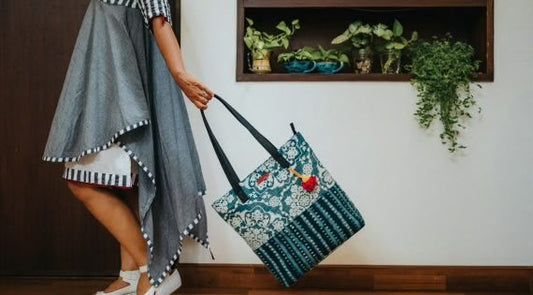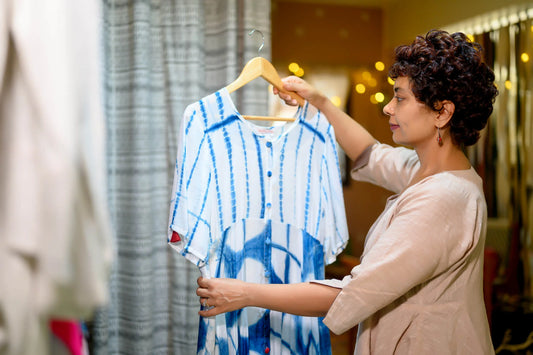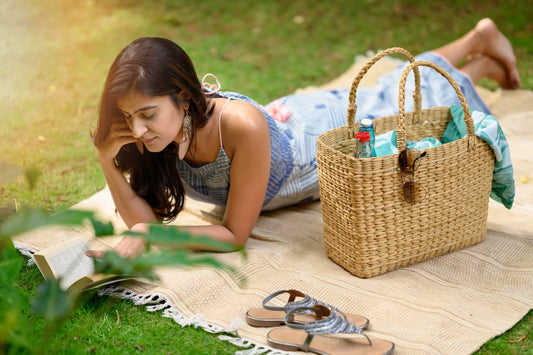If design gives body to an outfit, sustainability gives it--it’s soul.
What makes your favorite dress more special is probably because it’s unique. And what makes a dress unique and meaningful? Let’s find out the answer to this interesting thought…
The simplest answer can be that there aren’t too many or any other dress like that. But I urge you to look at it in depth and understand what goes behind those hand crafted unique pieces. This whole thought and practice is called sustainable fashion.
Sustainability in fashion comes from sourcing, manufacturing and designing clothes which maximizes the benefits to the industry and society at large. At the same time the goal is to have a system which works without leaving a negative footprint. Sustainable clothing is handcrafted from ethically sourced materials with fine hand detailing, which is labour intensive. That’s why one needs to change the perspective and look deep into this myth that sustainable clothing is actually expensive. Look at it in this way – by investing in sustainable fashion, you are also supporting the weaver or artisan working hard somewhere in remote rural India. You are also ensuring in reducing your carbon footprint.
How is sustainability connected with the society….
Sustainability is like a coin with two sides. On one side of this coin are the brands, which means creating and producing environment friendly products, with a high ecological integrity.
On the other side of the coin are the consumers. For consumers this means thinking about what you buy, knowing which philosophies you are supporting through your purchases. As professional men and women, we need to take responsibility for our daily choices. Commit to buying less, limit your outfits per day, and invest in pieces that last longer. Sport outfits that carry you throughout your busiest of days, from office conference room to your child’s play date.
This lockdown period gave me a lot of food for thought. Being a clothing brand, if we say to our customers that they should purchase less, it might come across as a conflicting plan to someone. But it has really made me think a lot about sustainability and sustainable fashion. Do we really need to crowd our closets with innumerous cheap factory made fast fashion clothes or rather focus on creating a minimal and conscious wardrobe with quality and ethical clothing.
What makes AMAR KOSA a sustainable brand?
First of all, our resources are sustainable- right from our ethically sourced raw materials to our handmade fabrics. All fabrics which we use are natural and environment friendly – Cotton, jute, linen, hemp, flax, silk are all sustainable fabrics. The leftover fabrics from the dresses are upcycled for making bags and smaller accessories hence creating less waste that goes into landfill. We are extremely conscious and aware of the environment and hence try to recycle all our waste to it’s maximum utilization.
Our staff is well paid and looked after by all means. Back in 2016 we started our brand with one tailor, Kitabul and his wife Mehnaaz. As we expanded and grew in size and number, we provided jobs to their other relatives and friends. Today we can proudly say that we generate livelihood to their entire community. With time, Kitabul and Mehnaaz have 2 kids and we look forward to take responsibility of these 2 children and empower them to become educated citizens of the future.
All the clothes made at AMAR KOSA are exclusively hand crafted, with special attention given to the smallest of details, which makes it so unique and rare. The dresses are custom made and of high quality. The fabrics used are woven manually by the weavers on hand-looms thus building up a sustainable ecosystem for all.
Here’s a quick re-cap at the glance, which points out the major difference between the two.
| Fast fashion | Sustainable fashion |
| Produced on a mass scale in bulk quantity | Single unique Pieces, handcrafted individually |
| Factory-made at lower price to sell to the mass market | Slightly higher in price, as it’s handmade uniquely and created on demand |
| Creates factory pollution and wastage | Lower carbon footprints, and (ideally) zero waste |
| Produced faster and cheap in quality | Encourages slower production, without compromising on the quality |
| Harsh on environment | Environment friendly |
| Often exploitation of the workers | Fair wages to the workers and artisans |
| Huge volumes of fabric is turned around within less time in power looms | Fabric is produced by weavers manually on handlooms, taking him longer time. |
So next time when you purchase a dress, do look for the story behind that dress!




